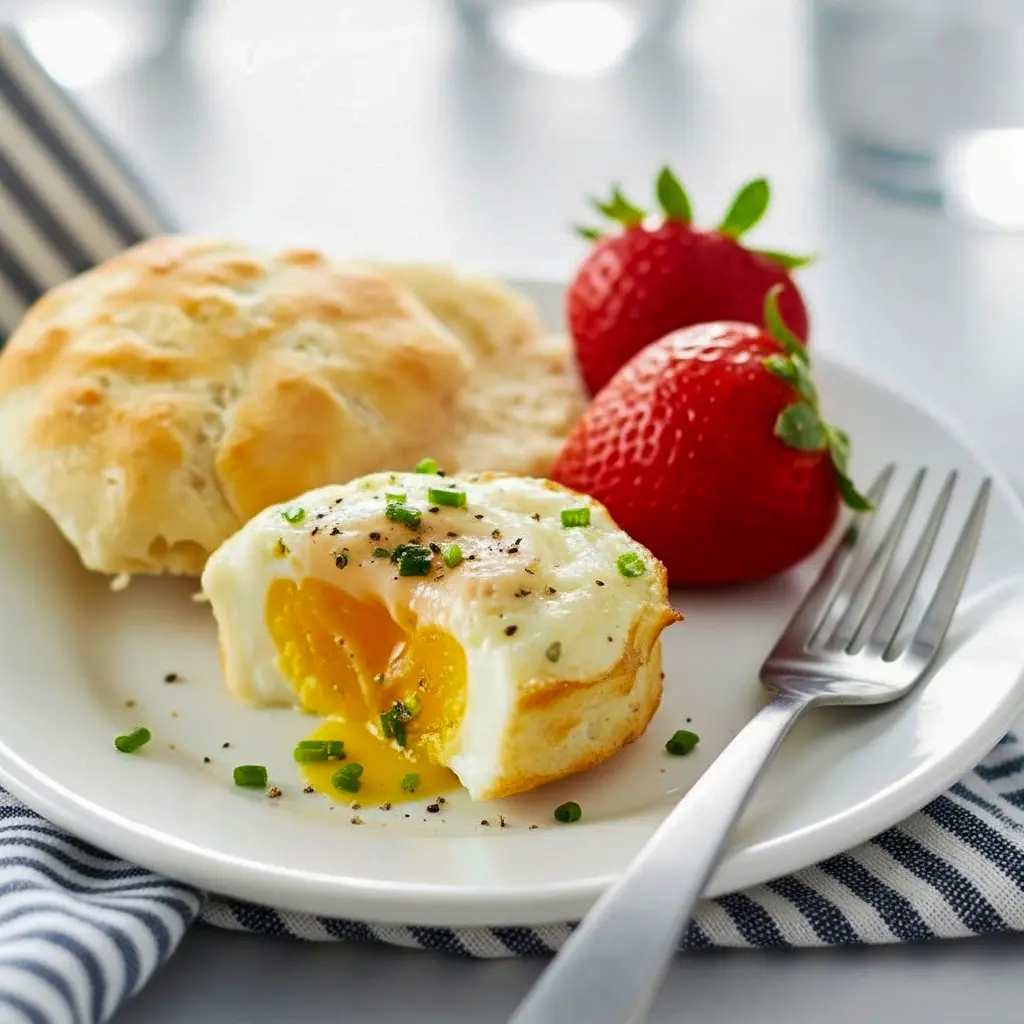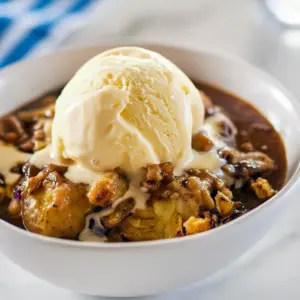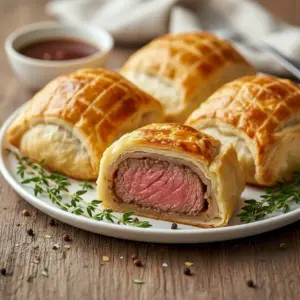French Eggs are the easiest way to make elegant breakfast for a crowd. Crack an egg into a muffin tin, add a splash of cream and a shower of Parmesan, bake a few minutes, and boom — you’ve got individual, perfectly set eggs that look fancy but took almost no effort. Sound good? Let’s dive in.
Why these baked eggs are impossible to resist
Think of these as the love child of comfort food and convenience. They’re creamy, savory, and customizable — plus they bake in a muffin pan so you can make a dozen at once. Want runny yolks? Done. Want firm, sliceable eggs for sandwiches? Also done. They pair with everything from toast to salad and even make brilliant party finger food. Bold tip: spritz the muffin tin so the eggs slide out cleanly.
What makes this recipe special (and simple)
- Minimal ingredients, maximum payoff.
- No water bath, no ramekins, no faff — just a muffin tin and an oven.
- They deliver the same comforting profile as a Classic French Egg Dish (oeufs en cocotte) but scale up to feed a crowd.
- They’re quick to assemble and easy to personalize, so they work for weeknight breakfasts and weekend brunches alike.
Ingredients — short notes on why each one matters
- Eggs (large or extra-large): the main event — protein-rich and versatile.
- Heavy cream or milk: a little fat makes the white tender and the yolk lush.
- Parmesan cheese: salty, nutty, umami — this is what elevates them into Baked Eggs With Parmesan Cheese territory.
- Salt & freshly ground pepper: small amounts sharpen everything.
- Butter or nonstick spray: prevents sticking and adds flavor.
Optional add-ins (tiny ideas that pack a punch): chopped chives, crispy bacon, diced ham, wilted spinach, sautéed mushrooms, or a pinch of chili flakes.
Simple equipment you’ll need
- Standard 12-cup muffin pan (metal or silicone).
- Small bowl for cracking eggs if you like avoiding shells in cups.
- Grater for the Parmesan.
- Small spatula or spoon to lift out the cooked eggs.
Bold tip: use a silicone muffin cup liner if you want fuss-free removal.
Quick, no-nonsense method (the one I use every time)
- Preheat oven to 425°F (220°C). Lightly grease each muffin cup with butter or cooking spray.
- Crack one egg into each cup. If you’re nervous about shells, crack into a small bowl first, then pour.
- Add 1–2 teaspoons of heavy cream (or milk) to each egg — just a drizzle.
- Season with a pinch of salt and pepper. Sprinkle about 1 teaspoon of grated Parmesan over each cup.
- Bake on the center rack: 10–12 minutes for runny yolks, 13–15 minutes for jammy yolks, 16–18 minutes for fully set. Oven temps vary, so check early.
- Remove from oven, let rest 1–2 minutes, then gently lift each egg out with a small spatula. Top with chopped herbs and serve.
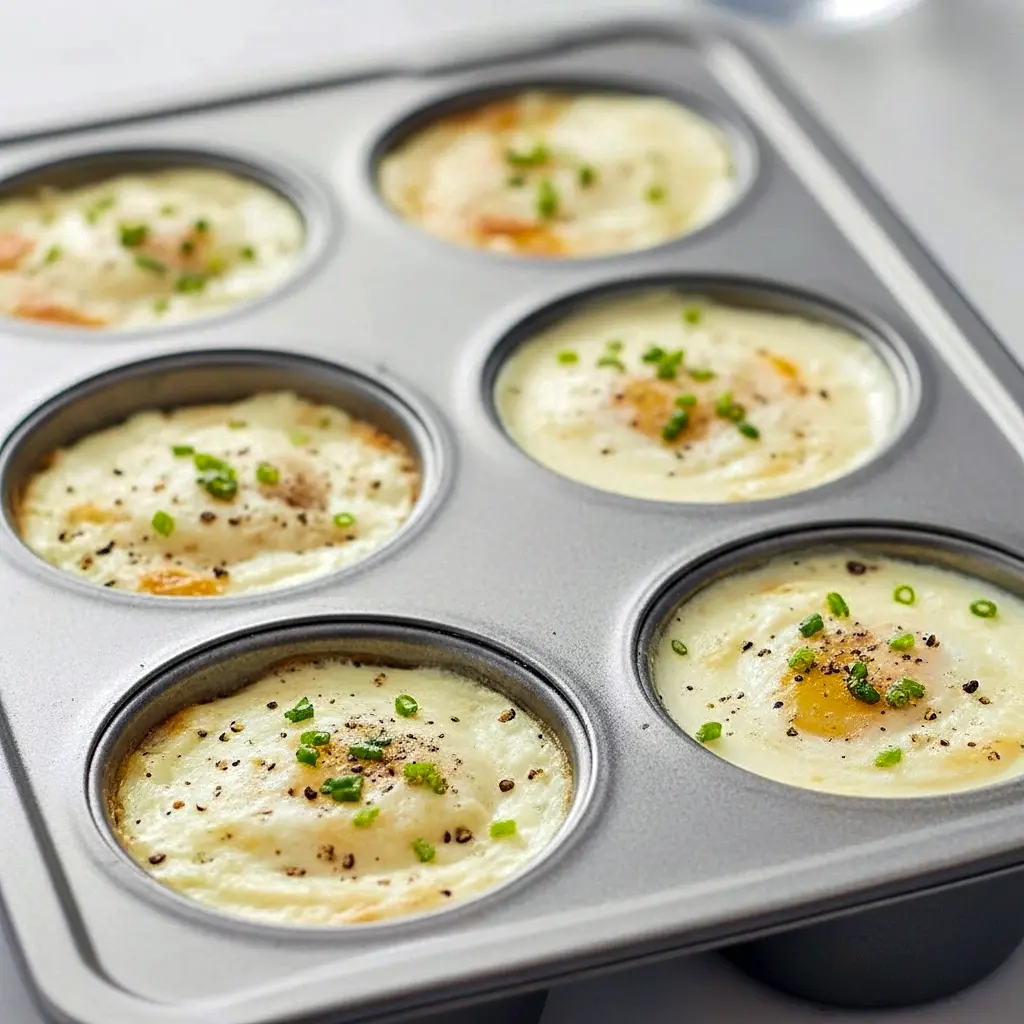
How to time them for perfect brunch service
If you’re feeding a crowd, start with the eggs that need the longest bake time and stagger the rest so everything finishes within a few minutes of each other. Keep cooked eggs warm on a low oven rack (200°F) while you finish the batch.
The story behind my version of this classic
I grew up watching my grandma make single-serving Classic French Egg Dish in little ramekins with cream and herbs. It felt like a ceremony — slow, careful, comforting. Years later, I realized I could get the same cozy effect with much less effort by using a muffin tin. No water bath, no fuss, and everyone gets their own little pot of goodness. My recipe keeps the French technique spirit but makes it totally modern and time-friendly.
Pro tips for flawless results
- Use room-temperature eggs if you can; they cook more evenly.
- Don’t over-salt before baking — cheese and toppings add salt, so season lightly.
- Want cheesier? Add a little shredded Gruyère or sharp cheddar along with or instead of Parmesan.
- Prevent sticking: grease well or use silicone liners. Bold tip: run a paring knife around the edge if they cling, then lift gently.
- For silky whites, lower the oven to 400°F and bake a bit longer — slower heat sets whites without rubbery texture.
- Make-ahead hack: bake eggs to 70–80% doneness, cool, refrigerate, and reheat 3–4 minutes in a 350°F oven. Perfect for busy mornings.
Delicious variations to suit every taste
- Meaty: Line each cup with a slice of ham or prosciutto, then crack the egg in — instant Egg Muffins with built-in protein.
- Veg-forward: Sauté spinach, mushrooms, or bell pepper first and spoon into the cups. Great for a Breakfast Recipes Casserole vibe.
- Spicy: Add a drop of sriracha or sprinkle smoked paprika and pepper jack.
- Herby: Fold chives, parsley, or thyme into the cream before adding.
- Vegan twist: For Vegan Muffins, use a chickpea flour batter or tofu scramble in muffin tins with nutritional yeast for cheesy notes. (Not eggs, but same muffin-pan convenience.)
Best ways to serve these little gems
- On toasted English muffins or slices of crusty sourdough.
- Nestled on a bed of greens for a lighter brunch plate.
- Stacked into breakfast sandwiches with bacon and avocado.
- As part of a brunch buffet: place them in warm chafing dishes or on heated platters.
Bold tip: sprinkle fresh herbs and extra Parmesan just before serving for visual and flavor sparkle.
Storage, reheating, and leftovers
- Fridge: Cool completely, then store in an airtight container for up to 5 days. Put parchment between layers to avoid smooshing.
- Reheat: Microwave in 10–15 second bursts until warm, or reheat in a 325°F oven for 8–10 minutes.
- Freeze: Yes — fully cooled eggs freeze well in a single layer, then stack with parchment. Reheat from frozen in a 350°F oven about 15–20 minutes.
Bold tip: if you plan to freeze, leave out delicate fresh herbs until after reheating.
FAQs — answers you actually need
Can I use medium or extra-large eggs?
Yes. Adjust baking time: medium eggs need slightly less time; extra-large need a bit more. Watch the yolk and test early.
Will the muffin-tin eggs be rubbery?
Not if you choose the right bake time. Lower temp + longer bake yields tender whites; high temp + short bake gives a firmer white and runny yolk.
How do I remove the eggs cleanly?
Grease the pan well, or use silicone liners. If stuck, slide a thin spatula around the edge and lift. A quick run under hot water warms the pan and loosens them.
Can I make these for guests with different dietary needs?
Absolutely. Offer a few Vegan Muffins (tofu scramble cups) alongside egg cups, and provide dairy-free cheese for lactose-intolerant guests.
Pairings and meal ideas
These baked eggs pair perfectly with:
- Crispy hash browns or home fries.
- Fresh fruit salad for contrast.
- A simple green salad and vinaigrette for lunch.
- Slices of smoked salmon and dill for a luxe brunch plate.
Why these are great for meal planning and hosting
They’re scalable, portable, and versatile. You can make a tray, refrigerate, and reheat when guests arrive. They work as a main for breakfast or a savory snack for cocktail hour. They fit into weeknight routines and holiday spreads alike — a true all-rounder.
Final thoughts — tiny jars of joy
If you want to level up your breakfast game without turning your morning into a production, these French Baked Eggs In Muffin Tin are the hack you didn’t know you needed. They capture the elegance of a Classic French Egg Dish while being as reliable as your favorite Egg Muffins. Whether you call them Easy Oven-baked Eggs, Baked Eggs With Parmesan Cheese, or just the best way to start your day — they’re easy to love and even easier to make.
Ready to try them? Grab a carton of eggs, preheat your oven, and prepare to impress. FYI: once you make these, you’ll never dread hosting brunch again.
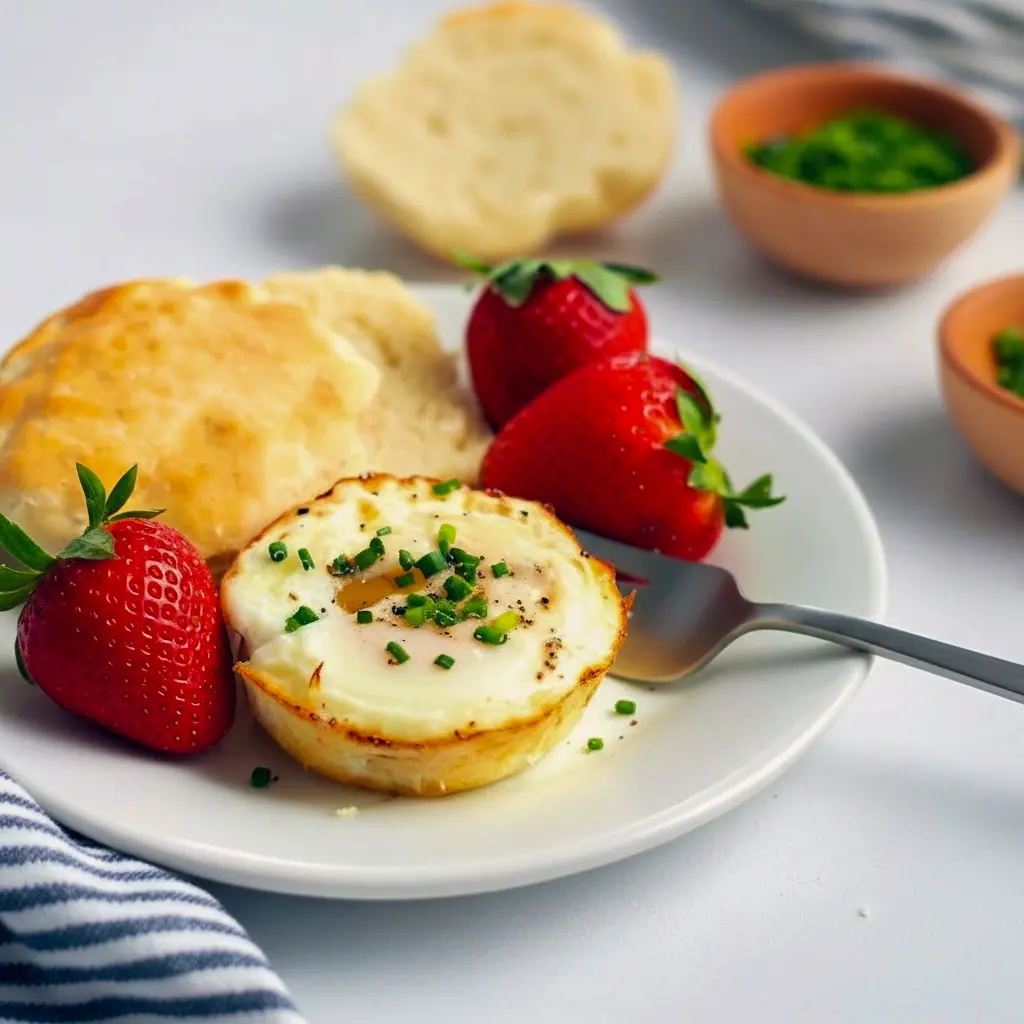

Baked French Eggs — Easy Oven-Baked Eggs with Parmesan Cheese
- Prep Time: 5 minutes
- Cook Time: 10 minutes
- Total Time: 15 minutes
- Yield: 12 eggs 1x
- Category: Breakfast
Ingredients
- 12 large eggs (or as many as you want)
- 8 oz grated Parmesan (or more to taste)
- About ½ cup heavy cream (adjust based on batch size)
- Salt and freshly ground black pepper
Instructions
- Preheat oven to 425°F (220°C). Lightly grease each well of a 12-cup muffin tin with butter spray or brush with melted butter.
- Crack one egg into every prepared cup (or crack into a small bowl first if you prefer to avoid shells).
- Spoon roughly 1–2 teaspoons of heavy cream over each egg (a little melted butter works fine here too).
- Season each egg with a pinch of salt and a grind or two of black pepper. Sprinkle about 1 tablespoon of the grated Parmesan across the tin, distributing it evenly.
- Bake on the middle rack until the whites and yolks reach your desired doneness: approximately 7–8 minutes for very soft yolks, 9–10 minutes for semi-runny, and 11–12 minutes for fully set yolks. Ovens vary, so start checking a minute or two early the first time you try this.
- Remove from the oven, let the eggs rest for 1–2 minutes, then gently lift them from the cups with a small spatula. Serve hot, finishing with extra Parmesan or fresh herbs if you like.
Notes
- Notes & Variations
- Add protein: Line each muffin well with ham, Canadian bacon, or prosciutto before cracking the egg for built-in protein.
- Veggie option: Spoon a little sautéed spinach, mushrooms, diced peppers, or shallots into each cup before adding the egg for a veggie-forward version.
- Seasoning ideas: Stir a pinch of crushed red pepper, smoked paprika, or a drop of hot sauce into the cream for heat; swap in garlic salt or minced garlic for a savory kick.
- Egg sizes: This timing is based on large eggs. Medium eggs will cook a touch faster; extra-large will need a bit more time — adjust as needed.
- Cream substitute: If you don’t have heavy cream, a drizzle of melted unsalted butter or a splash of whole milk will work (unsalted butter gives the best flavor).
- Cheese swaps: Parmesan is classic, but grated Gruyère, sharp cheddar, Asiago, or even crumbled feta or goat cheese make excellent alternatives.
- Doneness check: The center should still jiggle slightly for the best texture; overbaking produces rubbery whites.
- Fresh herbs: Top finished eggs with chopped chives, parsley, or thyme for brightness.
- Tips
- Grease the cups well (or use silicone liners) so the eggs come out easily.
- If the eggs cling, slide a thin spatula around the edge to free them.
- For a lower-heat, more tender white, bake at 400°F a little longer rather than blasting at a very high temp.
Serve these on toast, English muffins, or as part of a brunch board — simple, fast, and endlessly adaptable.
Nutrition
- Serving Size: 1serving
- Calories: 179kcal
- Sugar: 1g
- Sodium: 355mg
- Fat: 13g
- Saturated Fat: 7g
- Carbohydrates: 1g
- Protein: 13g
- Cholesterol: 194mg
